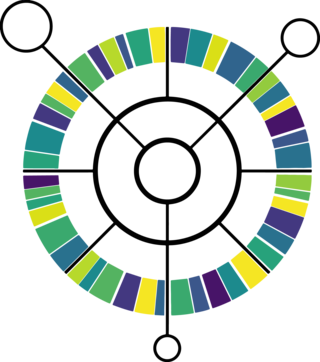Related Research Articles
The Gene Ontology (GO) is a major bioinformatics initiative to unify the representation of gene and gene product attributes across all species. More specifically, the project aims to: 1) maintain and develop its controlled vocabulary of gene and gene product attributes; 2) annotate genes and gene products, and assimilate and disseminate annotation data; and 3) provide tools for easy access to all aspects of the data provided by the project, and to enable functional interpretation of experimental data using the GO, for example via enrichment analysis. GO is part of a larger classification effort, the Open Biomedical Ontologies, being one of the Initial Candidate Members of the OBO Foundry.
BRENDA is an information system representing one of the most comprehensive enzyme repositories. It is an electronic resource that comprises molecular and biochemical information on enzymes that have been classified by the IUBMB. Every classified enzyme is characterized with respect to its catalyzed biochemical reaction. Kinetic properties of the corresponding reactants are described in detail. BRENDA contains enzyme-specific data manually extracted from primary scientific literature and additional data derived from automatic information retrieval methods such as text mining. It provides a web-based user interface that allows a convenient and sophisticated access to the data.
The Saccharomyces Genome Database (SGD) is a scientific database of the molecular biology and genetics of the yeast Saccharomyces cerevisiae, which is commonly known as baker's or budding yeast. Further information is located at the Yeastract curated repository.

The Pathogen-Host Interactions database (PHI-base) is a biological database that contains manually curated information on genes experimentally proven to affect the outcome of pathogen-host interactions. The database has been maintained by researchers at Rothamsted Research and external collaborators since 2005. PHI-base has been part of the UK node of ELIXIR, the European life-science infrastructure for biological information, since 2016.
FlyBase is an online bioinformatics database and the primary repository of genetic and molecular data for the insect family Drosophilidae. For the most extensively studied species and model organism, Drosophila melanogaster, a wide range of data are presented in different formats.

MicrobesOnline is a publicly and freely accessible website that hosts multiple comparative genomic tools for comparing microbial species at the genomic, transcriptomic and functional levels. MicrobesOnline was developed by the Virtual Institute for Microbial Stress and Survival, which is based at the Lawrence Berkeley National Laboratory in Berkeley, California. The site was launched in 2005, with regular updates until 2011.
SUPERFAMILY is a database and search platform of structural and functional annotation for all proteins and genomes. It classifies amino acid sequences into known structural domains, especially into SCOP superfamilies. Domains are functional, structural, and evolutionary units that form proteins. Domains of common Ancestry are grouped into superfamilies. The domains and domain superfamilies are defined and described in SCOP. Superfamilies are groups of proteins which have structural evidence to support a common evolutionary ancestor but may not have detectable sequence homology.
Protein function prediction methods are techniques that bioinformatics researchers use to assign biological or biochemical roles to proteins. These proteins are usually ones that are poorly studied or predicted based on genomic sequence data. These predictions are often driven by data-intensive computational procedures. Information may come from nucleic acid sequence homology, gene expression profiles, protein domain structures, text mining of publications, phylogenetic profiles, phenotypic profiles, and protein-protein interaction. Protein function is a broad term: the roles of proteins range from catalysis of biochemical reactions to transport to signal transduction, and a single protein may play a role in multiple processes or cellular pathways.

In molecular biology and genetics, DNA annotation or genome annotation is the process of describing the structure and function of the components of a genome, by analyzing and interpreting them in order to extract their biological significance and understand the biological processes in which they participate. Among other things, it identifies the locations of genes and all the coding regions in a genome and determines what those genes do.

EMAGE is an online biological database of gene expression data in the developing mouse embryo. The data held in EMAGE is spatially annotated to a framework of 3D mouse embryo models produced by EMAP. These spatial annotations allow users to query EMAGE by spatial pattern as well as by gene name, anatomy term or Gene Ontology (GO) term. EMAGE is a freely available web-based resource funded by the Medical Research Council (UK) and based at the MRC Human Genetics Unit in the Institute of Genetics and Molecular Medicine, Edinburgh, UK.

Blast2GO, first published in 2005, is a bioinformatics software tool for the automatic, high-throughput functional annotation of novel sequence data. It makes use of the BLAST algorithm to identify similar sequences to then transfers existing functional annotation from yet characterised sequences to the novel one. The functional information is represented via the Gene Ontology (GO), a controlled vocabulary of functional attributes. The Gene Ontology, or GO, is a major bioinformatics initiative to unify the representation of gene and gene product attributes across all species.
dcGO is a comprehensive ontology database for protein domains. As an ontology resource, dcGO integrates Open Biomedical Ontologies from a variety of contexts, ranging from functional information like Gene Ontology to others on enzymes and pathways, from phenotype information across major model organisms to information about human diseases and drugs. As a protein domain resource, dcGO includes annotations to both the individual domains and supra-domains.
In bioinformatics, the PANTHER classification system is a large curated biological database of gene/protein families and their functionally related subfamilies that can be used to classify and identify the function of gene products. PANTHER is part of the Gene Ontology Reference Genome Project designed to classify proteins and their genes for high-throughput analysis.
PomBase is a model organism database that provides online access to the fission yeast Schizosaccharomyces pombe genome sequence and annotated features, together with a wide range of manually curated functional gene-specific data. The PomBase website was redeveloped in 2016 to provide users with a more fully integrated, better-performing service.
Model organism databases (MODs) are biological databases, or knowledgebases, dedicated to the provision of in-depth biological data for intensively studied model organisms. MODs allow researchers to easily find background information on large sets of genes, plan experiments efficiently, combine their data with existing knowledge, and construct novel hypotheses. They allow users to analyse results and interpret datasets, and the data they generate are increasingly used to describe less well studied species. Where possible, MODs share common approaches to collect and represent biological information. For example, all MODs use the Gene Ontology (GO) to describe functions, processes and cellular locations of specific gene products. Projects also exist to enable software sharing for curation, visualization and querying between different MODs. Organismal diversity and varying user requirements however mean that MODs are often required to customize capture, display, and provision of data.

The Comprehensive Antibiotic Resistance Database (CARD) is a biological database that collects and organizes reference information on antimicrobial resistance genes, proteins and phenotypes. The database covers all types of drug classes and resistance mechanisms and structures its data based on an ontology. The CARD database was one of the first resources that covered antimicrobial resistance genes. The resource is updated monthly and provides tools to allow users to find potential antibiotic resistance genes in newly-sequenced genomes.
MEGARes is a hand-curated antibiotic resistance database which incorporates previously published resistance sequences for antimicrobial drugs, while also expanding to include published sequences for metal and biocide resistance determinants. In MEGARes 3.0, the nodes of the acyclic hierarchical ontology include four antimicrobial compound types, 59 classes, 223 mechanisms of resistance, and 1,448 gene groups that classify the 8,733 gene accessions. This works in conjunction with the AMR++ bioinformatics pipelin to classify resistome sequences directly from FASTA.
ARDB also known as Antibiotic Resistance Genes Database is a database that tracks antibiotic resistance genes with information such as mechanism of action, resistance profile, ontology, Clusters of Orthologous Genes (COG) and Conserved Domain Database (CDD) annotations. It also contains links to external databases. The database is also for the identification of new resistance genes. During the creation of ARDB in 2009, there was no comprehensive annotation system available. Thus, ontology terms for resistance profiles and mechanisms of actions were created for ARDB. Other things classified by ontology include drug target modification, drug enzymatic destruction and drug transport. Drug transporters are further subclassified by MFS Efflux pumps, SMR Efflux pumps, ABC Efflux pumps, RND Efflux pumps following conventions outlined in this paper. Currently, ARDB contains resistance information for 13,293 genes, 377 types, 257 antibiotics, 632 genomes, 933 species and 124 genera.
In molecular biology, MvirDB is a publicly available database that stores information on toxins, virulence factors and antibiotic resistance genes. Sources that this database uses for DNA and protein information include: Tox-Prot, SCORPION, the PRINTS Virulence Factors, VFDB, TVFac, Islander, ARGO and VIDA. The database provides a BLAST tool that allows the user to query their sequence against all DNA and protein sequences in MvirDB. Information on virulence factors can be obtained from the usage of the provided browser tool. Once the browser tool is used, the results are returned as a readable table that is organized by ascending E-Values, each of which are hyperlinked to their related page. MvirDB is implemented in an Oracle 10g relational database.
References
- ↑ Pal, C.; Bengtsson-Palme, J.; Rensing, C.; Kristiansson, E.; Larsson, D. G. (2014). "BacMet: antibacterial biocide and metal resistance genes database". Nucleic Acids Research. 42 (Database issue) (Database issue): D737–D743. doi:10.1093/nar/gkt1252. PMC 3965030 . PMID 24304895.
- ↑ Blake, J. A.; et al. (2013). "Gene Ontology annotations and resources". Nucleic Acids Research. 41 (Database issue) (Database issue): D530–D535. doi:10.1093/nar/gks1050. PMC 3531070 . PMID 23161678.